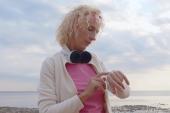Wearable Device Helps HF Patients Avoid Coming Back to the Hospital: BMAD
Though not randomized, the trial suggests clinicians and patients can benefit from remote monitoring of thoracic fluid buildup.

NEW ORLEANS, LA—A wearable sensor that detects fluid buildup in the lungs can help patients with heart failure avoid being readmitted to the hospital within 90 days, according to new data from the BMAD trial.
The remote-monitoring tool, known as μCor (Zoll Medical), is attached to the left side of patient’s chest and assesses thoracic fluid by using radiofrequency signals. It also can detect ECG, heart rate, respiration rate, activity, and posture.
“Annually, in the United States, more than 1 million patients are hospitalized with a primary diagnosis of heart failure, and this is expected to increase,” said John P. Boehmer, MD (Penn State Health, Hershey, PA), who presented the late-breaking findings Monday at the American College of Cardiology/World Congress of Cardiology (ACC/WCC) 2023 meeting.
Despite great strides made in medical therapy for HF, many patients still return to the hospital within the first few months after discharge, he noted. “Strategies and approaches aimed to reduce hospital readmissions have the potential to improve patient care as well as ease the burden on the healthcare system.”
A simple, noninvasive tool like this would be a welcome addition to the field, where the alternatives for HF monitoring are often implantable, like CardioMEMS, or bulky to wear. The μCor system received 510(k) clearance from the US Food and Drug Administration in 2018, with at least some real-world use prior to the BMAD trial.
To TCTMD, Boehmer said μCor “has limited penetration in the market right now, because we’re trying to get together the data on how it functions and be able to demonstrate an effective need for it. So now that we have some data on heart failure readmissions, I know a lot of clinics are planning on utilizing it more aggressively,” particularly in patients thought to be at high risk.
The length of time patients would need to wear the device is flexible, he added. Their trial involved 90 days of monitoring, with the potential to add another 90 days if desired, “or if you care to do it shorter—let’s say you’re focused on 30-day readmission—you can go 4-6 weeks and just focus on that time period, as well.”
Data Sent to Patients, Clinicians
Investigators enrolled 494 eligible patients within 10 days of being hospitalized for HF. All had experienced an HF event within the prior 6 months (hospitalization, visit to an emergency room or observation unit, or unplanned clinic visit where the patient received care for HF-related pulmonary congestion). There were no criteria set for LVEF.
The multicenter, multinational trial consisted of two arms:
- BMAD HF (control): Patients wore the monitor for up to 90 days, but the device didn’t share information with them or their clinician. This arm started first, so that researchers could determine which threshold should be used to identify normal versus elevated fluid levels.
- BMAD TX (intervention): Patients also wore the monitor for up to 90 days and information was transmitted to both them and their clinician, with action alerts given when their thoracic fluid index (TFI) exceeded 1.2 for at least 3 consecutive days. At this point, clinicians had the freedom to make changes to medication or lifestyle/diet, schedule an office visit, or make no changes at all.
In both groups, patients took part in weekly phone calls, monthly office visits, and follow-up phone calls at 6 months and 1 year. Follow-up for at least 90 days was available for 70% of the participants.
On Kaplan-Meier analysis, patients in the intervention group were a relative 38% less likely to be hospitalized for heart failure by 90 days (HR 0.62; P = 0.03). This translated to a 7% absolute reduction in risk and a number needed to treat of 14.3. Results were consistent across subgroups, including LVEF above or below 40%. The composite endpoint of HF hospitalization or emergency department visits and death also was reduced by 38%.
Both groups had gains in quality of life on the Kansas City Cardiomyopathy Questionnaire-12, though the intervention arm saw an increase that was 12 points higher than that of controls (P = 0.004). Nearly 70% given the intervention said they saw clinically meaningful improvement in quality of life, as compared with half of controls.
Patients are often reassured by knowing that somebody is watching how they’re doing and how they’re progressing as time goes on. John P. Boehmer
Lynne Warner Stevenson, MD (Vanderbilt University, Nashville, TN), the discussant in the late-breaking session, agreed that the results suggest the μCor system provides effective surveillance during the vulnerable time period after the initial HF hospitalization, though she highlighted the fact that BMAD wasn’t randomized.
A positive, in her opinion, was the inclusion of patients—not just physicians—in the information flow, said Stevenson. “Letting the patients see their data . . . is really important, because patients are in the center of these circles of management. More than one in five people are currently using commercial apps to monitor physiologic parameters. Patients are really no longer passive vehicles for us to drive. They’re actually becoming the engines for their health and outcomes.”
Noting the large improvement in quality of life, she asked if some of this stemmed from the insights patients got from the μCor system.
“My broad experience with remote monitoring, and also this trial, is that patients are often reassured by knowing that somebody is watching how they’re doing and how they’re progressing as time goes on,” said Boehmer. “So I think in general it’s a very positive experience for patients,” especially when the monitoring occurs during so vulnerable a time as after an HF hospitalization.
Biykem Bozkurt, MD, PhD (Baylor College of Medicine, Houston, TX), speaking with the media at an ACC/WCC press conference, said she is excited to see “yet another modality [added] to our armamentarium of remote monitoring, especially of fluid or congestion in the thoracic cavity.” It will be useful to know more about the specificity and sensitivity of its measurements in different populations, such as those with comorbidities like chronic kidney disease that also can involve fluid retention, she added. Future analyses also should look at how HF care changed as a result of knowing the TFI values.
A potential drawback is that looking at the data from the device and deciding how to apply that could require a lot of time on the part of physicians. “Healthcare is quite challenged right now with workforce availability,” she said, suggesting investigators could test whether patients might be interpret their own data and apply self-management strategies.
“I couldn’t agree more,” Boehmer said. “We don’t have the ability to scale the use of monitoring devices for heart failure when we’re managing every value that’s coming back, with a team that has to watch it.” He noted that this device and others might be amenable to a patient-driven approach, though first the interventions need to be developed and studied.
With the BMAD trial now complete, Boehmer said they are looking at next steps. “In terms of rollout of [μCor], there are some selected sites that are being targeted for clinical use right now, and again the goal is to learn by that experience and be able to refine how this is implemented in clinical practice,” he commented.
Caitlin E. Cox is News Editor of TCTMD and Associate Director, Editorial Content at the Cardiovascular Research Foundation. She produces the…
Read Full BioSources
Boehmer JP. Impact of heart failure management using thoracic fluid monitoring from a novel wearable sensor: results of the benefits of Microcor (μCor™) in ambulatory decompensated heart failure (BMAD) trial. Presented at: ACC/WCC 2023. March 6, 2023. New Orleans, LA.
Disclosures
- BMAD was funded by Zoll Medical Corporation, developer of the μCor system.
- Boehmer reports consultant fees/honoraria from BioVentrix, Boston Scientific, Medtronic, Respicardia; ownership interest/partnership/principal with Nanowear; and research grants from Abbott, Ancora Heart, Cardiol Therapeutics, Cardionomic, EBR Systems, Endotronix, V-Wave, and Zoll.





Comments